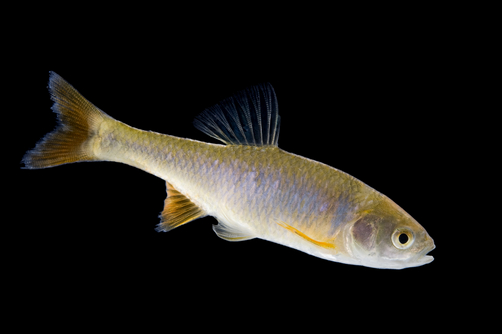Description
Potentially Misidentified Species - Notropis buccatus is a possibly introduced species, which is present in the Susquehanna, Potomac, and Rappahannock basins, and in one upper Bay tributary, but has not been found in the tidal waters of Chesapeake Bay (Musick 1972a; Jenkins and Burkhead 1993). The other species are native.
Taxonomy
| Kingdom | Phylum | Class | Order | Family | Genus |
|---|---|---|---|---|---|
| Animalia | Chordata | Osteichthyes | Cypriniformes | Cyprinidae | Cyprinella |
Synonyms
Invasion History
Chesapeake Bay Status
| First Record | Population | Range | Introduction | Residency | Source Region | Native Region | Vectors |
|---|---|---|---|---|---|---|---|
| 1974 | Probable Future Invader | Expanding | Introduced | Unconfirmed | North America | North America | Fisheries(Fisheries Accidental) |
History of Spread
Cyprinella lutrensis (Red Shiner) is native to the 'Missisippi River basin from south WI and east IN to SD and WY and south to LA.. Also in NM' (Page and Burr 1991). It is a widely used baitfish with exceptional colonizing abilities. It has been introduced to AZ and CA (Carlander 1969); widely introduced elsewhere (Page and Burr 1991). It has recently expanded its range in IL, AL, southwest United States; 'hybridizing with and threatening some native minnows' (Jenkins and Burkhead 1993).
Cyprinella lutrensis has not yet been collected in Chesapeake drainage, but has been introduced to the adjacent Roanoke drainage, 1974-75. It was propagated as a bait and aquarium fish in Kernsville NC, on the divide between Pee Dee and Roanoke systems and escaped. Its NC range appears to be confined to upper Piedmont and mountain region (map; Rodhe et al. 1994). It is 'expected to show up and gain a foothold, particularly in Piedmont waters' and 'could also become a bait bucket escapee in VA. It may also be introduced almost anywhere as an unwanted aquarium pet' (Jenkins and Burkhead 1993). Based on its preferences for flowing water, it may be no more than a stray in tidal waters, but is tolerant of turbidity and silt (Page and Burr 1991).
History References - Carlander 1969; Jenkins and Burkhead 1993; Page and Burr 1991; Rodhe et al. 1994
Invasion Comments
Residency- Cyprinella lutrensis has not yet been reported, in the Chesapeake Bay watershed, but has a strong possibility of colonizing the region (Jenkins and Burkhead 1993).
Ecology
Environmental Tolerances
| For Survival | For Reproduction | |||
|---|---|---|---|---|
| Minimum | Maximum | Minimum | Maximum | |
| Temperature (ºC) | 0.0 | 39.5 | ||
| Salinity (‰) | 0.0 | 11.5 | 0.0 | 0.0 |
| Oxygen | ||||
| pH | ||||
| Salinity Range | fresh-oligo |
Age and Growth
| Male | Female | |
|---|---|---|
| Minimum Adult Size (mm) | ||
| Typical Adult Size (mm) | ||
| Maximum Adult Size (mm) | ||
| Maximum Longevity (yrs) | ||
| Typical Longevity (yrs |
Reproduction
| Start | Peak | End | |
|---|---|---|---|
| Reproductive Season | |||
| Typical Number of Young Per Reproductive Event |
|||
| Sexuality Mode(s) | |||
| Mode(s) of Asexual Reproduction |
|||
| Fertilization Type(s) | |||
| More than One Reproduction Event per Year |
|||
| Reproductive Startegy | |||
| Egg/Seed Form |
Impacts
Economic Impacts in Chesapeake Bay
Cyprinella lutrensis (Red Shiner) has not yet been reported in the Chesapeake watershed, but is a threat to native nongame fishes. It is not likely to directly affect sport or game fishes if introduced.
Economic Impacts Outside of Chesapeake Bay
Cyprinella lutrensis (Red Shiner) is a widely used baitfish and an occasional aquarium fish (Jenkins and Burkhead 1993; Page and Burr 1991). Its sale as bait has been banned in most of CA, because of its threat to native species (Dill and Cordone 1997).
References- Jenkins and Burkhead 1993; Dill and Cordone 1997; Page and Burr 1991
Ecological Impacts on Chesapeake Native Species
Cyprinella lutrensis (Red Shiner) has been introduced in the Roanoke watershed (NC-VA) in the Piedmont region, but is not yet present in the Chesapeake Bay region. It is an aggressive colonizer which has adversely affected native species in the southwest United States (Dill and Cordone 1997; Jenkins and Burkhead 1993).
References- Dill and Cordone 1997; Jenkins and Burkhead 1993
Ecological Impacts on Other Chesapeake Non-Native Species
Cyprinella lutrensis (Red Shiner) has been introduced in the Roanoke watershed (NC-VA) in the Piedmont region, but not in the Chesapeake region yet (Jenkins and Burkhead 1993). It is a potential competitor with other introduced fishes as well as native.
References- Jenkins and Burkhead 1993
References
Carlander, Kenneth D. (1969) Handbook of freshwater fishery biology. Vol. 1., In: (Eds.) . , Ames. Pp.Dill, William A.; Cordone, Almo J. (1997) History and status of introduced fishes in California, 1871-1996, California Department of Fish and Game Fish Bulletin 178: 1-414
Jenkins, Robert E.; Burkhead, Noel M. (1993) Freshwater fishes of Virginia., , Bethesda, MD. Pp.
Musick, J. A.; Wiley, Martin L. (1972) Fishes of Chesapeake Bay and the adjacent coastal plain, Special Scientific Report, Virginia Institute of Marine Science 65: 175-212
Page, Lawrence M.; Burr, Brooks M. (1991) Freshwater Fishes., , Boston. Pp.
Renfro, William C. (1959) Survival and migration of fresh-water fishes in saltwater, Texas Journal of Science 11: 172-180
Rodhe, Fred C.; Arndt, Rudolf G.; Lindquist, David G.; Parnell, James F. (1994) Fishes of the Carolinas, Virginia, Maryland, and Delaware, , Chapel Hill. Pp.
